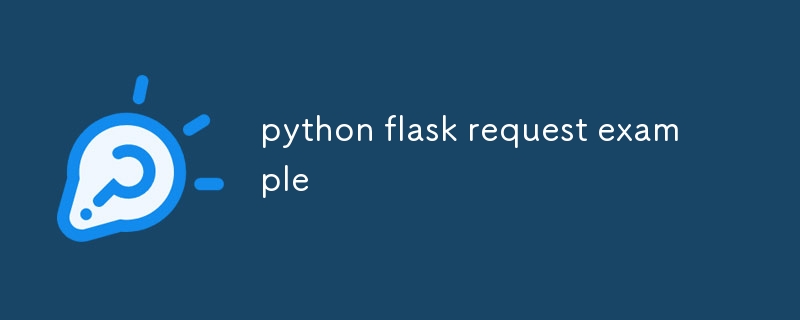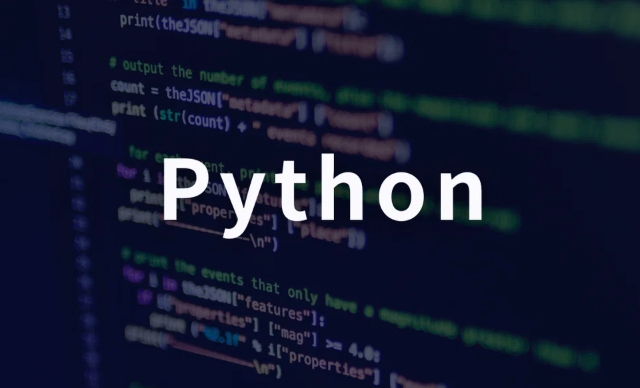The request object in Flask is used to obtain client request data. 1. Use request.args.get to obtain query parameters and specify type conversion; 2. Use request.form.get to obtain form data; 3. Use request.get_json() to parse JSON data. None is returned when non-JSON is not available; 4. Use request.method to obtain request method; 5. Use request.headers.get to obtain request header information; 6. Use request.files.get to handle file uploads, and make sure that the front-end sets enctype="multipart/form-data"; common attributes also include request.url and request.remote_addr. It is recommended to use get method to avoid KeyError, which basically covers various request data processing requirements in web development.

When developing web applications using Flask, request object is used to obtain HTTP request data sent by the client, such as form data, query parameters, JSON data, file upload, etc. Below is a practical example of using Flask request , covering common scenarios.

? Basic usage: Get different types of request data
from flask import Flask, request, jsonify
app = Flask(__name__)
@app.route('/data', methods=['GET', 'POST'])
def handle_data():
# 1. Get URL query parameters
# For example: /data?name=alice&age=25
name = request.args.get('name')
age = request.args.get('age', type=int) # Automatically convert to int
# 2. Get POST form data
# Applicable to content-type: application/x-www-form-urlencoded
username = request.form.get('username')
password = request.form.get('password')
# 3. Get JSON data# Applicable to content-type: application/json
json_data = request.get_json() # Return dict or None
if json_data:
email = json_data.get('email')
else:
email = None
# 4. Get the request method method = request.method
# 5. Get request header user_agent = request.headers.get('User-Agent')
# 6. Get file upload (if any)
uploaded_file = request.files.get('file')
filename = uploaded_file.filename if uploaded_file else 'No file'
# Return the collected data return jsonify({
'method': method,
'query_params': {'name': name, 'age': age},
'form_data': {'username': username, 'password': password},
'json_data': {'email': email},
'user_agent': user_agent,
'uploaded_file': filename
})
# Start the service if __name__ == '__main__':
app.run(debug=True)? Test example
You can use curl or Postman to test this interface.
Example 1: GET request with query parameters
curl "http://127.0.0.1:5000/data?name=bob&age=30"
Example 2: POST Submit Form
curl -X POST http://127.0.0.1:5000/data \
-d "username=admin" \
-d "password=123456"Example 3: Send JSON data
curl -X POST http://127.0.0.1:5000/data \
-H "Content-Type: application/json" \
-d '{"email": "test@example.com"}'Example 4: Upload a file
curl -X POST http://127.0.0.1:5000/data \
-F "file=@/path/to/your/file.txt" \
-F "username=john" ? Commonly used request attribute description
| property | illustrate |
|---|---|
request.args
|
Get URL query parameters (ImmutableMultiDict) |
request.form
|
Get form data |
request.get_json()
|
parses and returns the JSON request body |
request.files
|
Get uploaded files |
request.headers
|
Get request header information |
request.method
|
Current request method (GET, POST, etc.) |
request.url
|
Complete request URL |
request.remote_addr
|
Client IP address |
?? Notes
-
request.get_json()will returnNonein non-JSON requests, and it is best to judge before use. - Use
request.form.get('key')instead of direct indexing, avoid KeyError. - Make sure
enctype="multipart/form-data"is set when uploading the<form></form>. -
request.args.get('key', type=int)can automatically perform type conversion, and returnNoneif it fails.
Basically these common operations. Flask's request is lightweight but fully functional, suitable for fast processing of various inputs.

The above is the detailed content of python flask request example. For more information, please follow other related articles on the PHP Chinese website!

Hot AI Tools

Undress AI Tool
Undress images for free

Undresser.AI Undress
AI-powered app for creating realistic nude photos

AI Clothes Remover
Online AI tool for removing clothes from photos.

Clothoff.io
AI clothes remover

Video Face Swap
Swap faces in any video effortlessly with our completely free AI face swap tool!

Hot Article

Hot Tools

Notepad++7.3.1
Easy-to-use and free code editor

SublimeText3 Chinese version
Chinese version, very easy to use

Zend Studio 13.0.1
Powerful PHP integrated development environment

Dreamweaver CS6
Visual web development tools

SublimeText3 Mac version
God-level code editing software (SublimeText3)

Hot Topics
 Building RESTful APIs in Java with Jakarta EE
Jul 30, 2025 am 03:05 AM
Building RESTful APIs in Java with Jakarta EE
Jul 30, 2025 am 03:05 AM
SetupaMaven/GradleprojectwithJAX-RSdependencieslikeJersey;2.CreateaRESTresourceusingannotationssuchas@Pathand@GET;3.ConfiguretheapplicationviaApplicationsubclassorweb.xml;4.AddJacksonforJSONbindingbyincludingjersey-media-json-jackson;5.DeploytoaJakar
 A Developer's Guide to Maven for Java Project Management
Jul 30, 2025 am 02:41 AM
A Developer's Guide to Maven for Java Project Management
Jul 30, 2025 am 02:41 AM
Maven is a standard tool for Java project management and construction. The answer lies in the fact that it uses pom.xml to standardize project structure, dependency management, construction lifecycle automation and plug-in extensions; 1. Use pom.xml to define groupId, artifactId, version and dependencies; 2. Master core commands such as mvnclean, compile, test, package, install and deploy; 3. Use dependencyManagement and exclusions to manage dependency versions and conflicts; 4. Organize large applications through multi-module project structure and are managed uniformly by the parent POM; 5.
 css dark mode toggle example
Jul 30, 2025 am 05:28 AM
css dark mode toggle example
Jul 30, 2025 am 05:28 AM
First, use JavaScript to obtain the user system preferences and locally stored theme settings, and initialize the page theme; 1. The HTML structure contains a button to trigger topic switching; 2. CSS uses: root to define bright theme variables, .dark-mode class defines dark theme variables, and applies these variables through var(); 3. JavaScript detects prefers-color-scheme and reads localStorage to determine the initial theme; 4. Switch the dark-mode class on the html element when clicking the button, and saves the current state to localStorage; 5. All color changes are accompanied by 0.3 seconds transition animation to enhance the user
 css dropdown menu example
Jul 30, 2025 am 05:36 AM
css dropdown menu example
Jul 30, 2025 am 05:36 AM
Yes, a common CSS drop-down menu can be implemented through pure HTML and CSS without JavaScript. 1. Use nested ul and li to build a menu structure; 2. Use the:hover pseudo-class to control the display and hiding of pull-down content; 3. Set position:relative for parent li, and the submenu is positioned using position:absolute; 4. The submenu defaults to display:none, which becomes display:block when hovered; 5. Multi-level pull-down can be achieved through nesting, combined with transition, and add fade-in animations, and adapted to mobile terminals with media queries. The entire solution is simple and does not require JavaScript support, which is suitable for large
 python property decorator example
Jul 30, 2025 am 02:17 AM
python property decorator example
Jul 30, 2025 am 02:17 AM
@property decorator is used to convert methods into properties to implement the reading, setting and deletion control of properties. 1. Basic usage: define read-only attributes through @property, such as area calculated based on radius and accessed directly; 2. Advanced usage: use @name.setter and @name.deleter to implement attribute assignment verification and deletion operations; 3. Practical application: perform data verification in setters, such as BankAccount to ensure that the balance is not negative; 4. Naming specification: internal variables are prefixed, property method names are consistent with attributes, and unified access control is used to improve code security and maintainability.
 How to use Java MessageDigest for hashing (MD5, SHA-256)?
Jul 30, 2025 am 02:58 AM
How to use Java MessageDigest for hashing (MD5, SHA-256)?
Jul 30, 2025 am 02:58 AM
To generate hash values using Java, it can be implemented through the MessageDigest class. 1. Get an instance of the specified algorithm, such as MD5 or SHA-256; 2. Call the .update() method to pass in the data to be encrypted; 3. Call the .digest() method to obtain a hash byte array; 4. Convert the byte array into a hexadecimal string for reading; for inputs such as large files, read in chunks and call .update() multiple times; it is recommended to use SHA-256 instead of MD5 or SHA-1 to ensure security.
 python parse date string example
Jul 30, 2025 am 03:32 AM
python parse date string example
Jul 30, 2025 am 03:32 AM
Use datetime.strptime() to convert date strings into datetime object. 1. Basic usage: parse "2023-10-05" as datetime object through "%Y-%m-%d"; 2. Supports multiple formats such as "%m/%d/%Y" to parse American dates, "%d/%m/%Y" to parse British dates, "%b%d,%Y%I:%M%p" to parse time with AM/PM; 3. Use dateutil.parser.parse() to automatically infer unknown formats; 4. Use .d
 How to convert an Array to a List in Java?
Jul 30, 2025 am 01:54 AM
How to convert an Array to a List in Java?
Jul 30, 2025 am 01:54 AM
Converting an array into a list in Java requires selecting methods based on the data type and requirements. ① Use Arrays.asList() to quickly convert an object array (such as String[]) into a fixed-size List, but elements cannot be added or deleted; ② If you need a mutable list, you can encapsulate the result of Arrays.asList() through the ArrayList constructor; ③ For basic type arrays (such as int[]), you need to use StreamAPI conversion, such as Arrays.stream().boxed().collect(Collectors.toList()); ④ Notes include avoiding null arrays, distinguishing basic types from object types, and explicitly returning columns






